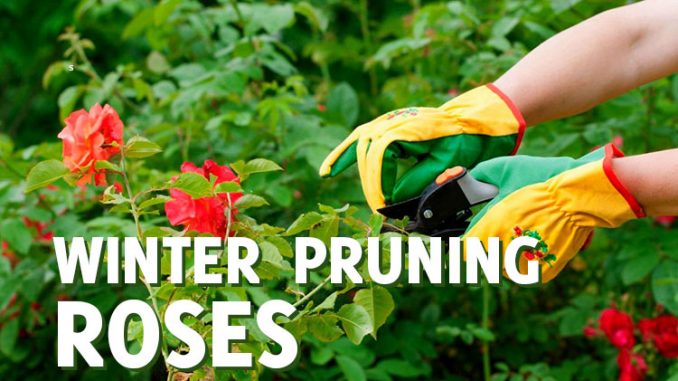
If you are reading this, then it is likely you know right around now is when you’re supposed to get out there and prune your roses. Or maybe you don’t if your rose book was authored back east and cautions you to “wait until the forsythia blooms in spring” before pruning your roses.
Around these parts, that advice is just plain whack! If you’re seeking rose advice from books, stick with regional guides like Sunset’s Roses. Healthy Roses is another regional book worth looking at. It’s brought to you by the smart folks at the University of California, Ag. & Natural Resources (ANR).
Rose Pruning for Winter Basics
If you’re still filled with trepidation about pruning your roses even after arming yourself with a good book, you’re not alone. It’s probably because you’ve heard that not only is there a right and wrong way to prune roses but that some roses shouldn’t be winter-pruned.
Your first job is to figure out which roses in your yard not to prune. That’d be your once-blooming old garden roses like albas and bourbons. These are generally pruned just after blooming (click here for the complete Sacramento Rose Society list). For descriptions of different rose types or “classes” also see the Weeks Roses website. If you’re like me and wouldn’t want to stake anyone’s life on an accurate old rose classification, I’d still say the odds are pretty good that existing roses in your yard are the commonly planted hybrid teas, grandifloras or floribundas… all of which can be pruned now. That’s just a guess, though, since I can’t actually see your roses… You really should get one of those books…
What to Prune:
Hybrid teas, grandifloras, floribundas, and tree roses, minis, climbers, “shrub roses” (like ‘Simplicity’) and certain repeat-blooming old-fashioned varieties.
When to Prune:
Late December through January.
Supplies:
Bypass pruners, loppers, pruning saw, and rose-pruning gloves.
How to Prune
The truth is, roses are much more forgiving than you realize. In fact, you could walk outside with a chainsaw and mow off about a third all growth and still be met with gorgeous blooms in spring. Most roses really are that forgiving. The downside to this method is that you will have done nothing to improve branch structure, spacing, and vigor. And your neighbors might think you’re nuts. Or lazy. Or both. Better to learn how to prune like a pro. It’s not that difficult…
The Basics
In general, you can safely shorten your rose bushes by 1/3 to 1/2. Now, here’s the really easy part! If a cane is dead or diseased, cut it off. If it’s spindly, meaning skinnier than a pencil, cut it off. If it’s angled inward, cut it off so it won’t cross with another inward-facing stem. If it’s a sucker originating from below the knobby bud union near the base of the plant, cut it off completely. If it’s old, unproductive wood (very gray and scarred looking), cut it off completely if there is a younger nearby cane to take its place. The best blooms come from young canes.
The Specifics
When shortening a cane by generally 1/3 to 1/2, cut approximately 1/4 inch above an outward-facing dormant bud (looks like a little eye and may or may not still have a leaf attached just below the bud.
Cutting to an outward-facing bud helps direct growth of new canes outward, creating an open vase shape.
Local rosarian Baldo Villegas recommends pruning hybrid teas and grandifloras by removing all but 4-6 nicely spaced canes. The remaining canes are pruned to a height of 2-3 feet. With floribundas, he recommends leaving 6-10 canes at a height of 1 1/2 – 2 1/2 feet from the bud union.
Minis can be sheared to within 8-15 inches of the ground. With climbers, you want to cut stem ends at about the point where they become as thick as a pencil. Since you want a somewhat flattened overall shape to complement the flat surface on which you’re training your climber, you can remove all lateral (side) shoots coming off your main horizontal “fan” of canes (see Baldo’s site for alternate techniques).
Shrub roses are often “hedged” back by about 1/3 every 2-3 years to control shape and size. For more about class-specific pruning guidelines, see Baldo Villegas’ Winter Rose Care Tips.
The Followup:
Remove any remaining leaves and spray with a fungicide/dormant oil combo. Baldo recommends this combo: fixed copper (Kocide or Microcoop) with Volck oil. A tank sprayer can be used for the application. If you have just a few roses, pick up a can of dormant rose spray at your local nursery. Check the label for application instructions.

Be the first to comment